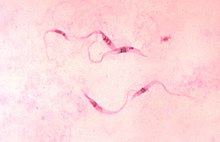(Adult Triatoma demidiata)
This was recently found to be true in Mexico's Yucatan peninsula, where street lights attract a group of insects called triatomines, also known as kissing bugs, conenose bugs, and assassin bugs. Triatomines are "hematophagous," meaning that they feed on vertebrate blood. As they do so, they may leave behind droppings infested with Trypanosoma cruzi, the parasite responsible for Chagas disease. If the parasite comes into contact with victims' blood streams--via the open bite wounds, for instance--it can cause an infection that has a treatable acute form, but a chronic form that may not appear for 10-20 years and can eventually lead to death via heart failure.
Light traps have long been used to capture triatomines in the wild, suggesting that the insects are attracted to artificial sources of illumination. Further, managers have previously noticed that these bugs are nonrandomly distributed in villages, and quickly re-infest houses after the application of pesticides. Cumulatively, these patterns suggested that the triatomines might cue in on street lamps and porch lights, preferentially infesting homes nearest these features.
This was the hypothesis tested by an international team of collaborators who utilized both observational and experimental methods to explore the dispersal of one triatomine, Triatoma dimidiata, in the Mexican villages of Bokoba, Teya, and Sudzal. Residents of the villages were asked to bring their insect invaders to the local health center, allowing the researchers to create a map of which homes were infested. Maps also included data on locations of public street lights and "peridomestic lights," or those illuminating porches and/or yards. Further, the researchers visited each home at night in order to measure the intensity of each light source. These data allowed them to investigate the differences in brightness between the two sources of light, and to evaluate whether infestation could be predicted by proximity to artificial illumination.
(Trypanosoma cruzi, the parasite responsible for Chagas disease)
Cumulatively, a total of 1466 houses were surveyed across the 3 villages, and only 214 of these (or 14.6%) were infested by T. dimidiata. Anthropogenic light sources were more commonly public (135-228 per village) than private (229 houses total), and both types of lighting had similar intensities (22-23 lux). The presence of peridomicile lighting only predicted infestation patterns in one village (Bokoba); however, infested houses were significantly closer to public lights in all three study sites. Specifically, more than 50% of infested houses were located near a public light, and the critical proximity appeared to be ~18 m.
In order to verify these patterns experimentally, the scientists caught both adult and nymph triatomines in order to perform a choice chamber experiment. Each bug was placed in the center of a chamber at either end of which was a different light treatment: The triatomines could choose to crawl through a tunnel leading to darkness or one leading towards light. Nymphs did not seem to display any preferences, but adults of both sex chose the lit end of the chamber significantly more often than the dark end; this dispersal activity was particularly high between 1 and 4 AM. The researchers then performed a second choice chamber experiment in which they investigated preferences for different components of the white light treatment--blue, yellow, or red wavelengths. Triatomines showed strong attraction to blue light, but only mild attraction to yellow, and none at all to red. In other words, the insects appeared to prefer shorter wavelengths over longer ones.
The authors of the study acknowledge that the data collection period for the field portion of their study was relatively brief. Despite this, they found a consistent relationship between public lighting and infestation across all 3 villages, regardless of local variations in potential confounding factors such as heat, weather, and vegetation. Further, these patterns were consistent with the results of their experimental study. Taken together, these findings suggest that triatomines cue in on public lights and, once they are in the neighborhood, make their way into the homes of residents unlucky enough to live in the glow of nearby street lamps.
(Feeding assassin bug)
Given the strong effect of public lighting, the researchers were surprised that peridomicile lights did not also seem to relate to infestation. One potential reason for this pattern is the time frame in which these different light sources are used; while street lamps are on all night--including during the 1-4 AM period when triatomine movement is greatest--porch and yard lights are often turned off around 10-11 PM when homeowners go to bed. Additionally, public lights are taller and often located in more open areas of the habitat, which means they may be visible to a larger portion of the local insect population.
One way of reducing triatomine infestation may be to dim or turn off street lights during the critical 1-4 AM time slot, or ensure that lights are not installed closer than ~20 m to nearby houses. Additionally, the researchers found that triatomines consistently migrated towards white light over yellow light when given a choice between the two; thus, use of yellow bulbs might be a good compromise in T. dimidiata-infested areas. This could be particularly true if white light traps are erected nearby, distracting the bugs away from street lamps and neighboring houses.
The authors also point out the utility of their geospatial analysis technique for predicting triatomine infestations. Although this method was employed here on only one species, they suggest that it is likely to be useful for other (vector-carrying) varieties of triatomine, as well. The resulting maps should aid in the detection of sites where infestation is so low that residents are unaware of the triatomines, but where there is still a very real risk of being bitten.
---
Pacheco-Tucuch, F.S., Ramirez-Sierra, M.J., Gourbiere, S., and Dumonteil, E. 2012. Public street lights increase house infestation by the Chagas disease vector Triatoma dimidiata. PLoS ONE 7(4):e36207.
Thanks to the following websites for providing the images used in this post:
http://en.wikipedia.org/wiki/Triatoma_dimidiata
http://en.wikipedia.org/wiki/Trypanosoma_cruzi
http://www.robotnine.com/2009/03/11-diseases-you-do-not-want-to-catch.html



No comments:
Post a Comment